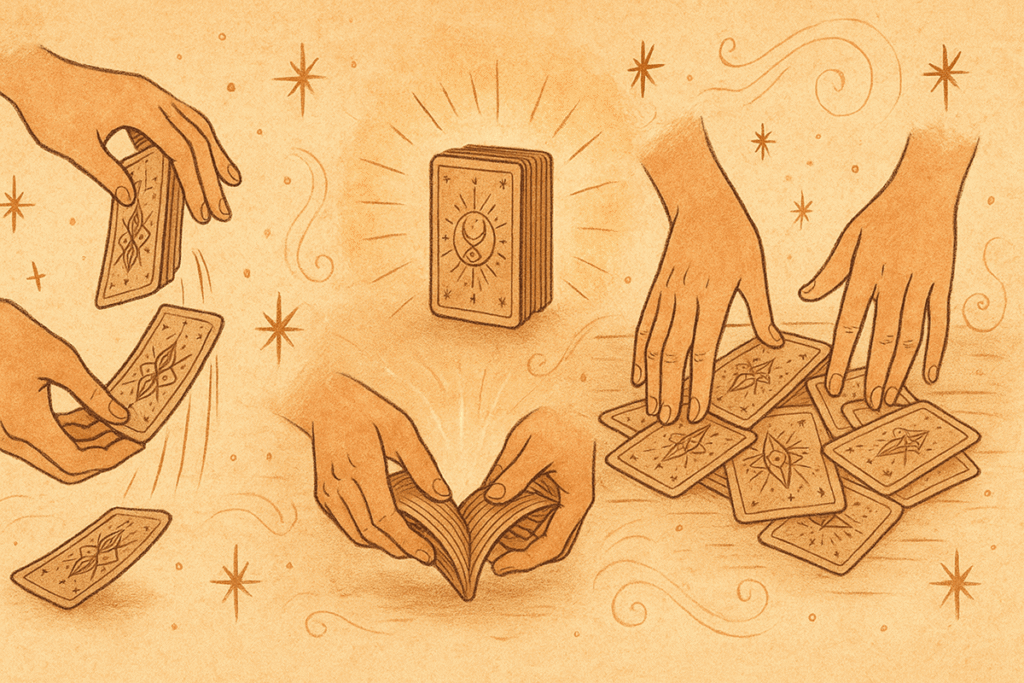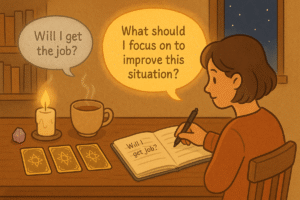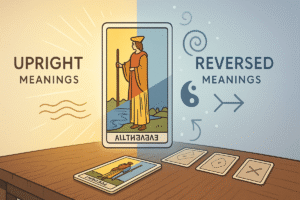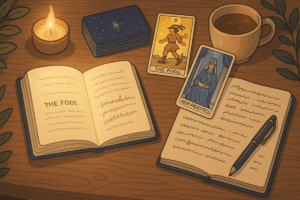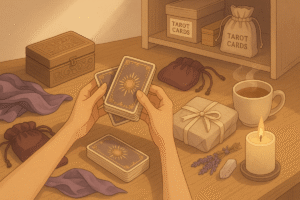Table of Contents
When I first picked up a tarot deck, I’ll admit I felt a bit silly about the shuffling part. How hard could it be, right? Well, it turns out there’s actually quite a bit more to it than I initially thought. Not in a complicated way, but in a meaningful way that goes beyond just mixing up the cards.
Shuffling tarot cards serves two important purposes. First, it randomizes the deck so your reading feels fresh and unpredictable. Second, and perhaps more importantly, it gives you a moment to center yourself and focus your intention for the reading ahead. Think of it as a bridge between your everyday mindset and the reflective space where tarot works best.
The beautiful thing about shuffling tarot cards is that there’s no single “correct” method. Different readers swear by different techniques, and honestly, what matters most is finding an approach that feels comfortable and natural for you. Some people prefer gentle, meditative shuffling methods, while others like more vigorous mixing. Both approaches are perfectly valid.
Understanding Your Tarot Deck Before You Shuffle
Before diving into specific shuffling techniques, it’s worth taking a moment to get familiar with your particular deck. Tarot cards are typically larger than standard playing cards, measuring about 2.75 by 4.75 inches, though this can vary between publishers. This extra size makes them feel different in your hands and affects how easily they shuffle.
New decks often feel stiff and resistant at first. The cards might stick together or feel awkward to manipulate. This is completely normal, and the deck will become more flexible with use. Some readers actually prefer to “break in” a new deck gradually, shuffling gently for the first few sessions to avoid bending or damaging the cards.
The card stock quality can also influence your shuffling choice. Higher quality decks with sturdy cardstock can handle more aggressive shuffling techniques, while decks with thinner or more delicate cards might require a gentler approach. When in doubt, start gentle and work your way up to more intensive methods as you get a feel for your deck’s durability.
The Overhand Shuffle
The overhand shuffle is probably the most intuitive and beginner-friendly technique. It’s the method most people naturally gravitate toward when they first pick up a tarot deck, and for good reason. It’s gentle, easy to control, and works well even if you have smaller hands or limited dexterity.
To perform an overhand shuffle, hold the deck in your non-dominant hand with your thumb on one side and your other fingers supporting the opposite side. Using your dominant hand, lift small sections of cards from the top or back of the deck and place them on the front. Repeat this motion, varying the size of the sections you lift, until you feel the deck has been sufficiently mixed.
The rhythm of this shuffle can be quite meditative. I often find myself naturally slowing down during an overhand shuffle, which creates a nice transition into the more focused mindset needed for a reading. Some readers like to count their shuffles, while others prefer to shuffle until it “feels right.” There’s no magic number here, just go with what feels appropriate for the moment.
One advantage of the overhand shuffle is that you have good control over the cards throughout the process. This makes it less likely that cards will fly out of your hands or get damaged. It’s also relatively quiet, which can be important if you’re reading in a shared space or prefer a more contemplative atmosphere.
The Riffle Shuffle
The riffle shuffle is the technique you’ve probably seen in movies or at card games. It creates that satisfying cascading sound as the cards fall together, and many people find it quite satisfying to perform. However, it does require a bit more skill and can potentially damage your cards if done incorrectly or too aggressively.
To riffle shuffle tarot cards, split the deck roughly in half and place the two halves on a flat surface with their corners touching. Using your thumbs, bend the cards slightly upward and let them fall together in an alternating pattern. The goal is to have the cards from each half interweave with each other.
I’ll be honest, riffle shuffling took me quite a while to master with tarot cards. The larger size makes them more unwieldy than regular playing cards, and the technique requires a certain amount of finger strength and coordination. Don’t worry if it feels clumsy at first; this is completely normal.
The main concern with riffle shuffling is the potential for card damage. The bending motion can create creases or wear marks, especially on lower quality card stock. Some collectors or readers who are particularly protective of their decks avoid this method entirely. However, if you’re gentle and your deck can handle it, the riffle shuffle can be very effective at randomizing the cards.
The Washing Method
The washing method, sometimes called the “messy pile” technique, is perhaps the most thorough way to randomize your tarot cards. It involves spreading the cards out on a flat surface and mixing them around in a seemingly chaotic fashion. While it might look haphazard, there’s actually a lot of intention behind this approach.
Start by placing all the cards face down on a clean, flat surface like a table or the floor. Using both hands, push the cards around in circular motions, mixing them thoroughly. The cards will naturally spread out and overlap in random patterns. Continue this process for as long as feels right, then gather the cards back into a neat stack.
This method appeals to readers who want to ensure complete randomization. Unlike other shuffling techniques where cards might stay in similar positions relative to each other, the washing method completely breaks up any existing order. It’s particularly useful when you’re using a new deck or when you feel like the cards have been getting “stuck” in certain patterns.
The washing method also has a certain tactile satisfaction to it. There’s something grounding about having your hands in contact with all the cards, and the physical act of spreading them out can help you feel more connected to the deck. Some readers find this method particularly effective for releasing any energy from previous readings.
The Hindu Shuffle
The Hindu shuffle offers a nice middle ground between the gentleness of the overhand shuffle and the thoroughness of the riffle shuffle. It’s a technique that comes from traditional card manipulation but works beautifully with tarot cards.
Hold the deck in your non-dominant hand, gripping it from the sides with your thumb on one edge and your middle finger on the opposite edge. With your dominant hand, pull small packets of cards from the top of the deck, allowing them to fall into your palm. Continue this process, letting each new packet fall on top of the previous ones.
What I like about the Hindu shuffle is its flowing, rhythmic quality. The motion becomes almost hypnotic after a while, which can help you transition into a more intuitive mindset. It’s also relatively gentle on the cards while still providing good randomization.
This technique allows for nice variation in packet size and timing. You might pull larger sections sometimes and smaller ones at other times, or vary the speed of your movements. These variations help ensure thorough mixing while keeping the process feeling natural and unforced.
Combining Techniques for Better Results
Many experienced readers don’t stick to just one shuffling method. Instead, they combine different techniques within a single session to achieve better randomization and maintain their connection to the process. For example, you might start with some washing to completely break up the deck’s order, then move to overhand shuffling while focusing your intention for the reading.
The combination approach also helps prevent your shuffling from becoming too routine or mechanical. When you vary your methods, you’re more likely to stay present and engaged with the process rather than going through the motions automatically.
Some readers like to use different techniques for different types of readings. They might use gentle overhand shuffling for daily personal draws but switch to more thorough washing for important decision-making readings. There’s no right or wrong approach here; it’s about finding what works for your practice.
Setting Your Intention While Shuffling
Perhaps the most important aspect of shuffling isn’t the technique itself but what’s happening in your mind while you shuffle. This is your opportunity to set an intention for the reading and create a focused mental space for reflection.
Some readers prefer to formulate a specific question before they begin shuffling. Others like to start with a general sense of what they want to explore and let the question clarify itself during the shuffling process. Both approaches work well; it’s really about finding what feels most natural for your reading style.
The physical act of shuffling can be remarkably centering. The repetitive motions and focus required help quiet the mental chatter that might otherwise interfere with your reading. I often find that solutions to problems or new perspectives on situations arise during the shuffling process, even before I’ve drawn any cards.
Common Shuffling Mistakes to Avoid
While there’s no “wrong” way to shuffle tarot cards, there are a few common pitfalls that can interfere with your reading experience. Being too rough with the cards is probably the most obvious mistake. Aggressive shuffling might damage your deck and can also create a tense energy that doesn’t serve the reflective nature of tarot work.
On the flip side, being overly precious about the shuffling process can also be counterproductive. Some beginners get so worried about doing it “right” that they lose the natural, intuitive flow that makes shuffling effective. Remember, the goal is randomization and intention setting, not perfect technique.
Another common issue is rushing through the shuffle. While you don’t need to shuffle for an hour, giving yourself enough time to feel centered and focused will improve your overall reading experience. Pay attention to your own rhythms and don’t feel pressured to match someone else’s timing.
When to Stop Shuffling
Knowing when to stop shuffling is often more art than science. Some readers count shuffles, some shuffle for a set amount of time, and others rely on intuitive cues. All of these approaches can work effectively.
I tend to shuffle until it feels complete, which usually coincides with feeling mentally ready for the reading. Sometimes this happens quickly, other times it takes longer. The key is staying present with the process rather than going through predetermined motions.
Physical cues can also signal when it’s time to stop. Cards jumping out of the deck, a natural pause in your shuffling rhythm, or simply feeling like the cards are ready can all be good indicators. Trust your instincts here; your unconscious mind is often better at recognizing these moments than your analytical mind.
Building Your Personal Shuffling Style
As you gain experience with tarot, you’ll likely develop your own unique shuffling preferences and rituals. This personal style reflects your individual relationship with the cards and can become an important part of your reading practice.
Some readers develop elaborate shuffling sequences that help them transition into a reading mindset. Others prefer to keep things simple and spontaneous. Neither approach is better; what matters is finding methods that support your connection to the cards and enhance your reading experience.
Your shuffling style might also evolve over time as your practice deepens. Techniques that felt awkward initially might become second nature, while methods you once relied on might feel less appealing. This evolution is natural and can reflect your growing confidence and changing relationship with tarot.
The most important thing to remember is that shuffling is a personal practice. What works beautifully for one reader might feel completely wrong for another. Trust your instincts, be patient with yourself as you learn, and remember that the best shuffling technique is the one that helps you create meaningful, insightful readings.
Frequently Asked Questions
Should I let someone else touch or shuffle my tarot cards?
This is entirely a matter of personal preference, with experienced readers holding different views on the topic. Some readers ask clients to shuffle the cards themselves, believing this helps transfer the client’s energy to the deck and creates a more personal connection to the reading. Others prefer to handle all the shuffling themselves to maintain their own energetic connection with the cards and protect the deck from potential damage. If you do readings for others, you might find that having clients shuffle while you chat helps them relax and feel more involved in the process. There’s no right or wrong answer here. Consider what feels most comfortable for your practice, and remember that you can always cleanse your deck afterward if someone else has handled it.
What does it mean when cards jump out of the deck while I’m shuffling?
Cards that jump or fall out during shuffling are often called “jumper cards,” and many readers view them as carrying special significance for the reading. The importance might vary depending on how the card falls. A single card that flips energetically and lands face up is often considered more significant than several cards clumsily falling out at once. Some readers set jumpers aside as additional messages or themes for the reading, while others simply shuffle them back into the deck. If you’re still learning to shuffle and know you tend to be clumsy, you can probably disregard most dropped cards. However, if you’re generally good at shuffling and a card jumps out unexpectedly, it might be worth paying attention to. Trust your intuition about whether a jumper feels meaningful or accidental.
How do I shuffle if I want to read reversed cards?
If you read reversals, the washing or “granny shuffle” method works best because swirling cards face down on a surface naturally rotates some of them upside down. You can also introduce reversals during the overhand shuffle by occasionally rotating part of the deck 180 degrees before continuing to shuffle. If you don’t read reversals, the overhand shuffle keeps all cards facing the same direction, which some readers prefer to avoid the confusion of seeing reversed cards during their reading. Decide before you start shuffling whether you want reversals in your reading, and choose your method accordingly.
How long should I shuffle my tarot cards?
There’s no specific rule about shuffling duration. The key is to shuffle until the cards feel sufficiently mixed and you feel mentally ready for the reading. Some readers shuffle until the cards begin to stick together or clump, using this as a physical sign that they’re done. Others count their shuffles or shuffle for a set amount of time. The most important thing is using the shuffling time to focus your intention and create the right mindset for your reading. Sometimes this happens quickly, other times it takes longer. Pay attention to your own rhythms rather than trying to meet an arbitrary number.

